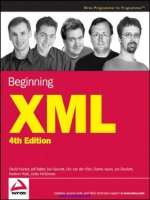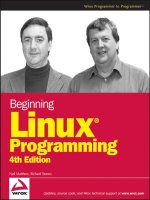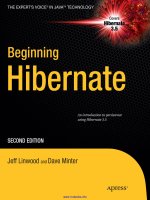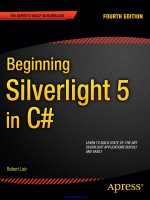Beginning XML 4th Edition doc
Bạn đang xem bản rút gọn của tài liệu. Xem và tải ngay bản đầy đủ của tài liệu tại đây (19.71 MB, 1,255 trang )
www.it-ebooks.info
Beginning XML
4th Edition
David Hunter,
Jeff Rafter,
Joe Fawcett,
Eric van der Vlist,
Danny Ayers,
Jon Duckett,
Andrew Watt, and
Linda McKinnon
01_114872 ffirs.qxp 4/16/07 6:36 PM Page iii
www.it-ebooks.info
Beginning XML
4th Edition
01_114872 ffirs.qxp 4/16/07 6:36 PM Page i
www.it-ebooks.info
01_114872 ffirs.qxp 4/16/07 6:36 PM Page ii
www.it-ebooks.info
Beginning XML
4th Edition
David Hunter,
Jeff Rafter,
Joe Fawcett,
Eric van der Vlist,
Danny Ayers,
Jon Duckett,
Andrew Watt, and
Linda McKinnon
01_114872 ffirs.qxp 4/16/07 6:36 PM Page iii
www.it-ebooks.info
Beginning XML, 4
th
Edition
Published by
Wiley Publishing, Inc.
10475 Crosspoint Boulevard
Indianapolis, IN 46256
www.wiley.com
Copyright © 2007 by Wiley Publishing, Inc., Indianapolis, Indiana
Published simultaneously in Canada
ISBN: 978-0-470-11487-2
Manufactured in the United States of America
10 9 8 7 6 5 4 3 2 1
Library of Congress Cataloging-in-Publication Data:
Beginning XML / David Hunter [et al.]. 4th ed.
p. cm.
ISBN 978-0-470-11487-2 (paper/website)
1. XML (Document markup language) I. Hunter, David, 1974 May 7-
QA76.76.H94B439 2007
006.7’4 dc22
2007006580
No part of this publication may be reproduced, stored in a retrieval system or transmitted in any form or by any means,
electronic, mechanical, photocopying, recording, scanning or otherwise, except as permitted under Sections 107 or 108 of
the 1976 United States Copyright Act, without either the prior written permission of the Publisher, or authorization
through payment of the appropriate per-copy fee to the Copyright Clearance Center, 222 Rosewood Drive, Danvers, MA
01923, (978) 750-8400, fax (978) 646-8600. Requests to the Publisher for permission should be addressed to the Legal
Department, Wiley Publishing, Inc., 10475 Crosspoint Blvd., Indianapolis, IN 46256, (317) 572-3447, fax (317) 572-4355, or
online at www.wiley.com/go/permissions.
LIMIT OF LIABILITY/DISCLAIMER OF WARRANTY: THE PUBLISHER AND THE AUTHOR MAKE NO REPRE-
SENTATIONS OR WARRANTIES WITH RESPECT TO THE ACCURACY OR COMPLETENESS OF THE CONTENTS OF
THIS WORK AND SPECIFICALLY DISCLAIM ALL WARRANTIES, INCLUDING WITHOUT LIMITATION WAR-
RANTIES OF FITNESS FOR A PARTICULAR PURPOSE. NO WARRANTY MAY BE CREATED OR EXTENDED BY
SALES OR PROMOTIONAL MATERIALS. THE ADVICE AND STRATEGIES CONTAINED HEREIN MAY NOT BE
SUITABLE FOR EVERY SITUATION. THIS WORK IS SOLD WITH THE UNDERSTANDING THAT THE PUBLISHER IS
NOT ENGAGED IN RENDERING LEGAL, ACCOUNTING, OR OTHER PROFESSIONAL SERVICES. IF PROFES-
SIONAL ASSISTANCE IS REQUIRED, THE SERVICES OF A COMPETENT PROFESSIONAL PERSON SHOULD BE
SOUGHT. NEITHER THE PUBLISHER NOR THE AUTHOR SHALL BE LIABLE FOR DAMAGES ARISING HERE-
FROM. THE FACT THAT AN ORGANIZATION OR WEBSITE IS REFERRED TO IN THIS WORK AS A CITATION
AND/OR A POTENTIAL SOURCE OF FURTHER INFORMATION DOES NOT MEAN THAT THE AUTHOR OR THE
PUBLISHER ENDORSES THE INFORMATION THE ORGANIZATION OR WEBSITE MAY PROVIDE OR RECOM-
MENDATIONS IT MAY MAKE. FURTHER, READERS SHOULD BE AWARE THAT INTERNET WEBSITES LISTED IN
THIS WORK MAY HAVE CHANGED OR DISAPPEARED BETWEEN WHEN THIS WORK WAS WRITTEN AND
WHEN IT IS READ.
For general information on our other products and services please contact our Customer Care Department within the
United States at (800) 762-2974, outside the United States at (317) 572-3993 or fax (317) 572-4002.
Trademarks: Wiley, the Wiley logo, Wrox, the Wrox logo, Programmer to Programmer, and related trade dress are trade-
marks or registered trademarks of John Wiley & Sons, Inc. and/or its affiliates, in the United States and other countries,
and may not be used without written permission. All other trademarks are the property of their respective owners. Wiley
Publishing, Inc., is not associated with any product or vendor mentioned in this book.
Wiley also publishes its books in a variety of electronic formats. Some content that appears in print may not be available
in electronic books.
01_114872 ffirs.qxp 4/16/07 6:36 PM Page iv
www.it-ebooks.info
I would like to thank God, for continuing to give me opportunities to do
what I love; my church family, for giving me more support than I deserve;
and Andrea, for giving me more support than anyone deserves.
I would also like to thank the editors, for their constant help.
Their dedication to the quality of this book was a major factor in its success.
—David
To Ali and Jude, for their loving patience.
—Jeff
To my two brothers, Peter and Stephen, who have both helped me in my life
and career in their own ways, many thanks.
—Joe
To my wife, Catherine, and children, Deborah, David, Samuel, and Sarah,
for their patience and support while I am busy writing books.
—Eric
To my late grandmother, Mona Cartledge, who once gave me a
Commodore Pet.
—Danny
01_114872 ffirs.qxp 4/16/07 6:36 PM Page v
www.it-ebooks.info
About the Authors
David Hunter is a Senior Technical Consultant for CGI, a full-service IT and business process services
partner. Providing technical leadership and guidance for solving his clients’ business problems, he is a
jack-of-all-trades and master of some. With a career that has included design, development, support,
training, writing, and other roles, he has had extensive experience building scalable, reliable, enterprise-
class applications. David loves to peek under the hood at any new technology that comes his way, and
when one catches his fancy, he really gets his hands dirty. He loves nothing more than sharing these
technologies with others.
Jeff Rafter is an independent consultant based in Redlands, California. His focus is on emerging tech-
nology and web standards, including XML and validation. He currently works with Baobab Health
Partnership with a focus on improving world health.
Joe Fawcett (
e) started programming in the 1970s and worked briefly in IT
when leaving full-time education. He then pursued a more checkered career before returning to software
development in 1994. In 2003 he was awarded the title of Microsoft Most Valuable Professional in XML
for community contributions and technical expertise; he has subsequently been re-awarded every year
since. Joe currently works in London and is head of software development for FTC Kaplan Ltd., a lead-
ing international provider of accountancy and business training.
Eric van der Vlist is an independent consultant and trainer. His domains of expertise include web devel-
opment and XML technologies. He is the creator and main editor of XMLfr.org, the main site dedicated
to XML technologies in French, the lead author of Professional Web 2.0 Programming, the author of the
O’Reilly animal books XML Schema and RELAX NG and a member or the ISO DSDL (
)
working group focused on XML schema languages. He is based in Paris and can be reached at
, or meet him at one of the many conferences where he presents his projects.
Danny Ayers is a freelance developer and consultant specializing in cutting-edge web technologies.
His blog (
) tends to feature material relating to the Semantic Web and/or
cat photos.
Linda McKinnon has more than 10 years of experience as a successful trainer and network engineer,
assisting both private and public enterprises in network architecture design, implementation, system
administration, and RFP procurement. She is a renowned mentor and has published numerous Linux
study guides for Wiley Press and Gearhead Press.
01_114872 ffirs.qxp 4/16/07 6:36 PM Page vi
www.it-ebooks.info
Credits
Senior Acquisitions Editor
Jim Minatel
Development Editors
Sara Shlaer
Lisa Thibault
Technical Editor
Phred Menyhert
Production Editor
William A. Barton
Copy Editor
Luann Rouff
Editorial Manager
Mary Beth Wakefield
Production Manager
Tim Tate
Vice President and Executive Group Publisher
Richard Swadley
Vice President and Executive Publisher
Joseph B. Wikert
Graphics and Production Specialists
Brooke Graczyk
Denny Hager
Joyce Haughey
Jennifer Mayberry
Barbara Moore
Alicia B. South
Quality Control Technician
John Greenough
Project Coordinator
Lynsey Osborn
Media Development Specialists
Angie Denny
Kit Malone
Kate Jenkins
Steve Kudirkan
Proofreading
Aptara
Indexing
Broccoli Information Management
Anniversary Logo Design
Richard Pacifico
01_114872 ffirs.qxp 4/16/07 6:36 PM Page vii
www.it-ebooks.info
01_114872 ffirs.qxp 4/16/07 6:36 PM Page viii
www.it-ebooks.info
Acknowledgments
This book would not have been possible without the work of the many developers dedicated to improv-
ing the Web through standards. We would also like to thank the countless contributors to mailing lists,
IRC channels, forums, and friends that have helped us through the difficult corners of the specifications
and technologies presented in this book.
Thanks to Nicholas C. Zakas for his ideas and assistance in implementing the AutoSuggest Control. Many
thanks to Phillip Pearson, who runs TopicExchange.com. He provided much-needed technical support
that otherwise would have meant rewriting most of Chapter 14. We would also like to thank Jim Ley and
Doug Schepers for their assistance on the case study and Chapter 19. Special thanks to our lead editor,
Sara Shlaer, for her gentle and not so gentle persuasive powers and attention to detail; to editor Lisa
Thibault, for her thoughtful assistance; and to Phred Menyhert, for a rigorous technical edit. Many thanks
to our acquisitions editor, Jim Minatel, who has shepherded this book through many incarnations.
01_114872 ffirs.qxp 4/16/07 6:36 PM Page ix
www.it-ebooks.info
01_114872 ffirs.qxp 4/16/07 6:36 PM Page x
www.it-ebooks.info
Contents
Acknowledgments ix
Introduction xxvii
Part I: Introduction 1
Chapter 1: What Is XML? 3
Of Data, Files, and Text 3
Binary Files 4
Text Files 5
A Brief History of Markup 6
So What Is XML? 7
What Does XML Buy Us? 10
HTML and XML: Apples and Red Delicious Apples 13
Hierarchies of Information 14
What’s a Document Type? 17
No, Really — What’s a Document Type? 18
Origin of the XML Standards 18
What Is the World Wide Web Consortium? 18
Components of XML 19
Where XML Can Be Used, and What You Can Use It For 20
Reducing Server Load 20
Website Content 20
Distributed Computing 21
e-Commerce 21
Summary 22
Exercise Questions 22
Question 1 22
Question 2 22
Chapter 2: Well-Formed XML 23
Parsing XML 24
Tags and Text and Elements, Oh My! 24
Rules for Elements 31
02_114872 ftoc.qxp 4/16/07 6:36 PM Page xi
www.it-ebooks.info
xii
Contents
Attributes 39
When to Use Attributes 43
Comments 45
Empty Elements 49
XML Declarations 50
Version 51
Encoding 51
Standalone 53
Processing Instructions 56
Illegal PCDATA Characters 59
Escaping Characters 60
CDATA Sections 61
Errors in XML 64
Summary 64
Exercise Questions 65
Question 1 65
Question 2 65
Chapter 3: XML Namespaces 67
Why We Need Namespaces 67
Using Prefixes 69
Why Doesn’t XML Just Use These Prefixes? 70
How XML Namespaces Work 72
Default Namespaces 75
Do Different Notations Make Any Difference? 81
Namespaces and Attributes 83
Understanding URIs 86
URLs 86
URNs 87
Why Use URLs for Namespaces, Not URNs? 87
What Do Namespace URIs Really Mean? 88
RDDL 89
When to Use Namespaces 89
Summary 90
Exercise Questions 91
Question 1 91
Question 2 91
Question 3 91
02_114872 ftoc.qxp 4/16/07 6:36 PM Page xii
www.it-ebooks.info
xiii
Contents
Part II: Validation 93
Chapter 4: Document Type Definitions 95
Running the Samples 96
Preparing the Ground 96
The Document Type Declaration 100
Sharing Vocabularies 104
Anatomy of a DTD 105
Element Declarations 105
Attribute Declarations 120
Entities 131
Developing DTDs 141
DTD Limitations 142
DTD Syntax 142
XML Namespaces 143
Data Typing 143
Limited Content Model Descriptions 143
Summary 143
Exercise Questions 144
Question 1 144
Question 2 144
Question 3 144
Chapter 5: XML Schemas 145
Benefits of XML Schemas 146
XML Schemas Use XML Syntax 146
XML Schema Namespace Support 146
XML Schema Data Types 147
XML Schema Content Models 147
Do We Still Need DTDs? 147
XML Schemas 148
The XML Schema Document 148
Running the Samples 148
<schema> Declarations 152
<element> Declarations 155
<complexType> Declarations 165
<group> Declarations 167
Content Models 168
<attribute> Declarations 177
<attributeGroup> Declarations 183
02_114872 ftoc.qxp 4/16/07 6:36 PM Page xiii
www.it-ebooks.info
xiv
Contents
Creating Elements with Simple Content and Attributes 185
Datatypes 186
<simpleType> Declarations 193
Creating a Schema from Multiple Documents 200
<import> Declarations 200
<include> Declarations 204
Documenting XML Schemas 206
Comments 206
Attributes from Other Namespaces 207
Annotations 208
Summary 209
Exercise Questions 210
Question 1 210
Question 2 210
Question 3 210
Chapter 6: RELAX NG 211
XML and Compact Syntaxes 212
Running the Samples 212
RELAX NG Patterns 213
Element, Attribute, and Text Patterns 213
Combining and Reusing Patterns and Grammars 227
Named Patterns 227
Combining Named Pattern Definitions 230
Schema Modularization Using the include Directive 231
Redefining Included Named Patterns 232
Removing Patterns with the notAllowed Pattern 233
Extensions and Restrictions 234
Nested Grammars 235
Additional RELAX NG Features 236
Namespaces 236
Name-Classes 237
Datatypes 241
List Patterns 243
Comments and Divisions 244
Useful Resources 245
Summary 245
Exercise Questions 245
Question 1 246
Question 2 246
02_114872 ftoc.qxp 4/16/07 6:36 PM Page xiv
www.it-ebooks.info
xv
Contents
Part III: Processing 247
Chapter 7: XPath 249
Ways of Looking at an XML Document 250
Modeling XML Documents 250
Visualizing XPath 251
Understanding Context 252
What Is a Node? 254
XPath 1.0 Types 257
Abbreviated and Unabbreviated Syntax 259
XPath 1.0 Axes 260
Child Axis 260
attribute Axis 262
ancestor Axis 264
ancestor-or-self Axis 265
descendant Axis 265
descendant-or-self Axis 266
following Axis 266
following-sibling Axis 268
namespace Axis 268
parent Axis 271
preceding Axis 271
preceding-sibling Axis 272
self Axis 273
XPath 1.0 Functions 274
Boolean Functions 274
Node-Set Functions 275
Numeric Functions 275
String Functions 276
Predicates 278
Structure of XPath Expressions 278
XPath 2.0 281
Revised XPath Data Model 281
W3C XML Schema Data Types 281
Additional XPath 2.0 Functions 282
XPath 2.0 Features 282
Summary 285
Exercise Questions 285
Question 1 286
Question 2 286
02_114872 ftoc.qxp 4/16/07 6:36 PM Page xv
www.it-ebooks.info
xvi
Contents
Chapter 8: XSLT 287
What Is XSLT? 287
Restructuring XML 288
Presenting XML Content 288
How an XSLT Processor Works 288
Running the Examples 289
Introducing the Saxon XSLT Processor 289
Installing the Saxon XSLT Processor 290
Procedural versus Declarative Programming 292
Procedural Programming 292
Declarative Programming 292
Foundational XSLT Elements 293
The <xsl:stylesheet> Element 295
The <xsl:template> Element 296
The <xsl:apply-templates> Element 296
Getting Information from the Source Tree 297
The <xsl:value-of> Element 297
The <xsl:copy> Element 299
The <xsl:copy-of> Element 303
Influencing the Output with the <xsl:output> Element 306
Conditional Processing 306
The <xsl:if> Element 306
The <xsl:choose> Element 308
The <xsl:for-each> Element 311
The <xsl:sort> Element 312
XSLT Modes 314
XSLT Variables and Parameters 320
Named Templates and the <xsl:call-template> Element 322
XSLT Functions 323
XSLT 2.0 323
Grouping in Version 2.0 324
Non-XML Input and String Handling 327
Multiple Outputs 330
User-Defined Functions 332
xsl:value-of changes 334
Summary 335
Exercise Questions 335
Question 1 335
Question 2 335
02_114872 ftoc.qxp 4/16/07 6:36 PM Page xvi
www.it-ebooks.info
xvii
Contents
Part IV: Databases 337
Chapter 9: XQuery, the XML Query Language 339
Why XQuery? 340
Historical Factors 340
Technical Factors 340
Current Status 341
XQuery Tools 343
Saxon 343
X-Hive.com Online 345
X-Hive Database 346
Tamino Database 346
Microsoft SQL Server 2005 346
Oracle 346
Some XQuery Examples 346
Input Functions 346
Retrieving Nodes 348
Element Constructors 351
The XQuery Prolog 355
Computed Constructors 358
Syntax 359
The XQuery Data Model 360
Shared Data Model with XPath 2.0 and XSLT 2.0 360
Node Kinds 361
Sequences of Node-Sets 361
Document Order 361
Comparing Items and Nodes 361
Types in XQuery 361
Axes in XQuery 361
XQuery Expressions 362
FLWOR Expressions 362
XQuery Functions 368
The concat() Function 369
The count() Function 369
Using Parameters with XQuery 370
User-Defined Functions 371
Looking Ahead 372
Update Functionality 372
Full-Text Search 372
Summary 372
02_114872 ftoc.qxp 4/16/07 6:36 PM Page xvii
www.it-ebooks.info
xviii
Contents
Exercise Questions 373
Question 1 373
Question 2 373
Chapter 10: XML and Databases 375
The Need for Efficient XML Data Stores 375
The Increasing Amount of XML 376
Comparing XML-Based Data and Relational Data 377
Approaches to Storing XML 378
Storing XML on File Systems 378
Using XML With Conventional Databases 379
Native XML Databases 381
Using Native XML Databases 382
Obtaining and Installing eXist 382
Interacting with eXist 384
XML in Commercial RDBMSs 395
XML Functionality in SQL Server 2000 395
Web Service Support 426
XML in Open Source RDBMS 426
Installing MySQL 426
Adding Information in MySQL 427
Querying MySQL 430
Updating XML in MySQL 435
Usability of XML in MySQL 436
Client-Side XML Support 437
Choosing a Database to Store XML 438
Looking Ahead 438
Summary 438
Exercise Questions 438
Question 1 439
Question 2 439
Question 3 439
Part V: Programming 441
Chapter 11: The XML Document Object Model (DOM) 443
Purpose of the XML DOM 443
Interfaces and Objects 445
The Document Object Model at the W3C 446
XML DOM Implementations 447
02_114872 ftoc.qxp 4/16/07 6:36 PM Page xviii
www.it-ebooks.info
xix
Contents
Two Ways to View DOM Nodes 448
Overview of the XML DOM 448
Tools to Run the Examples 450
Browser Differences 450
The Node Object 458
Properties of the Node Object 458
Methods of the Node Object 461
Loading an XML Document 462
The Effect of Text Nodes 468
The NamedNodeMap Object 471
The NodeList Object 475
The DOMException Object 476
The Document Interface 478
How the XML DOM Is Used in InfoPath 2007 481
Summary 482
Exercise Questions 482
Question 1 482
Question 2 482
Chapter 12: Simple API for XML (SAX) 483
What Is SAX and Why Was It Invented? 483
A Brief History of SAX 484
Where to Get SAX 485
Setting Up SAX 486
Receiving SAX Events 486
ContentHandler Interface 487
ErrorHandler Interface 504
DTDHandler Interface 509
EntityResolver Interface 510
Features and Properties 510
Extension Interfaces 514
Good SAX and Bad SAX 515
Consumers, Producers, and Filters 516
Other Languages 516
Summary 517
Exercise Questions 518
Question 1 518
Question 2 518
02_114872 ftoc.qxp 4/16/07 6:36 PM Page xix
www.it-ebooks.info
xx
Contents
Part VI: Communication 519
Chapter 13: RSS, Atom, and Content Syndication 521
Syndication and Meta Data 521
Syndication Systems 522
The Origin of RSS Species 525
RSS-DEV and RSS 1.0 529
UserLand and RSS 2.0 531
Atom 533
Working with News Feeds 536
Newsreaders 536
Data Quality 536
A Simple Aggregator 537
Modeling Feeds 537
Program Flow 540
Implementation 540
Transforming RSS with XSLT 557
Useful Resources 567
Summary 568
Exercise Questions 568
Question 1 569
Question 2 569
Chapter 14: Web Services 571
What Is an RPC? 571
RPC Protocols 573
DCOM 573
IIOP 574
Java RMI 575
The New RPC Protocol: Web Services 575
XML-RPC 576
The Network Transport 579
Taking a REST 596
The Web Services Stack 600
SOAP 600
WSDL 601
UDDI 602
Surrounding Specifications 602
Summary 604
02_114872 ftoc.qxp 4/16/07 6:36 PM Page xx
www.it-ebooks.info
xxi
Contents
Exercise Questions 605
Question 1 605
Question 2 605
Chapter 15: SOAP and WSDL 607
Laying the Groundwork 608
Running Examples in Windows 2003, XP, and 2000 608
The New RPC Protocol: SOAP 608
Just RESTing 612
Basic SOAP Messages 613
More Complex SOAP Interactions 620
Defining Web Services: WSDL 632
<definitions> 633
<types> 633
<messages> 634
<portTypes> 635
<binding> 635
<soap:body> 637
<service> 638
Other Bindings 641
Summary 644
Exercise Questions 644
Question 1 644
Question 2 644
Chapter 16: Ajax 645
Early Attempts at Asynchronous Updates 645
Microsoft versus Mozilla 647
Cross-Browser Solutions 647
Basic Posting Techniques 649
Transport and Processing on the Server 652
JSON 652
Payment Card Validator 653
The AutoSuggest Box 658
Server-Side Proxies 681
The Currency Converter Proxy 682
Summary 686
Exercise Questions 687
Question 1 687
Question 2 687
Question 3 687
02_114872 ftoc.qxp 4/16/07 6:36 PM Page xxi
www.it-ebooks.info
xxii
Contents
Part VII: Display 689
Chapter 17: Cascading Style Sheets (CSS) 691
Why Stylesheets? 692
Introducing CSS 693
CSS Properties 694
Inheritance 695
Attaching the Stylesheet to an XML Document 699
Selectors 700
Using CSS for Layout of XML Documents 701
Understanding the Box Model 702
Positioning in CSS 706
Laying Out Tabular Data 719
Links in XML Documents 721
XLink Support in Firefox 721
Forcing Links Using the XHTML Namespace 725
Images in XML Documents 725
Using CSS to Add Content to Documents 726
Attribute Content 729
Attribute Selectors 729
Using Attribute Values in Documents 729
Summary 732
Exercise Questions 732
Question 1 732
Question 2 733
Question 3 733
Question 4 733
Chapter 18: XHTML 735
Separating Style from Content 736
Learning XHTML 1.x 738
Document Type Definitions for XHTML 738
Basic Changes in Writing XHTML 740
Styling XHTML Documents 751
Stricter Documents Make Faster and Lighter Processors 753
XHTML Tools 753
Validating XHTML Documents 754
Validation Pitfalls 756
Mime Types Pitfalls 757
02_114872 ftoc.qxp 4/16/07 6:36 PM Page xxii
www.it-ebooks.info
xxiii
Contents
Modularized XHTML 759
Module Implementations 761
XHTML 1.1 761
XHTML Basic 762
What’s Next for XHTML 763
Summary 765
Exercise Questions 766
Question 1 766
Question 2 766
Chapter 19: Scalable Vector Graphics (SVG) 767
What Is SVG? 767
Scalable, Vector, Graphics 768
Putting SVG to Work 769
An SVG Toolkit 769
Getting Started 771
Views and Units 774
The Painter’s Model 774
Grouping 776
Transformations 776
Paths 777
Images 780
Text 781
Comments, Annotation, and Metadata 782
Scripting 784
SVG on Your Website 785
Tangram: A Simple Application 786
XHTML Wrapper 787
SVG Shapes 788
Tangram Script 792
Useful Resources 799
Summary 800
Exercise Questions 800
Question 1 800
Question 2 801
Chapter 20: XForms 803
How XForms Improves on HTML Forms 804
XForms Tools 804
An Illustrative XForms Example 810
02_114872 ftoc.qxp 4/16/07 6:36 PM Page xxiii
www.it-ebooks.info









